St. Valentine to Vinegar Valentines and on to Sweethearts in Love



For him, or possibly two different fellows named Valentine, it didn’t end well. He (or they) were martyred as Christians.

From the collection of the Wellcome Library, London.
St. Valentine is depicted here healing a sufferer of epilepsy. Notice the heart in the upper left-hand corner. This is more representative of a human heart (than the shape of a Valentine's heart) and possibly suggests compassion for the ill as coming from our heart.
As we've seen in the examples above as well as this one, it's an easy transition to imagine going from this shape and symbol, to our more familiar, decorative shape of a heart that commemorates Valentine's Day today.
Valentine's day has its roots in at least three cultural traditions: Roman, Pagan, and Christian.
The early Christian church often strategically incorporated pagan holidays and customs into the Christian calendar to make the new religion seem more welcoming and familiar to those practicing paganism.
For example, the Christian celebration of St. Valentine’s Day, celebrating love, family, and healing, was intentionally situated on approximately the day of the spring equinox. The spring equinox was a historic pagan commemoration of new beginnings and fertility. So combining these two celebrations was a natural weaving together of the two cultures.
Next Up, Geoffrey Chaucer
The 14th Century poet and storyteller, Geoffrey Chaucer was the first to associate St. Valentine’s Day with a romantic love interest. In his 1375 poem “Parliament of Foules,” he writes:
For this was sent on Seynt Valentyne’s day
Whan every foul cometh ther to choose his mate.’”
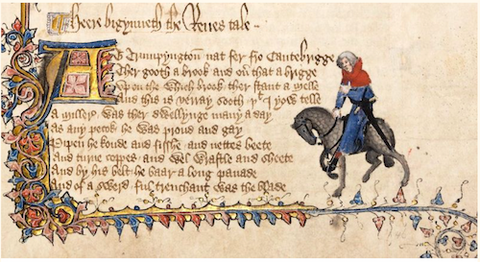
Image from Canterbury Tales. From "The Hub News, Notes, Talk," February 17, 2022. By Walker Caplan.
Pinnacle of Valentine Interest in the Victorian Era
I think the peak interest in sending Valentine's was in the Victorian era. Couples were prevented from expressing outward displays of affection, yet could pen letters, poems, sonnets, on Valentine's to privately convey their feelings.
And even unwelcome feelings could be expressed privately to the embarrassment or shame of the recipient. I was surprised to learn of Vinegar Valentines, which were like a rude social media posts.
To My Valentine
Tis a lemon that I hand you and bid you now ‘skidoo,’
Because I love another—there is no chance for you,”
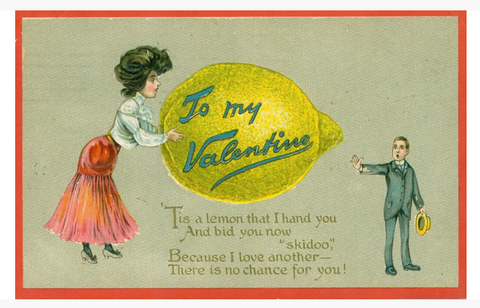
Jan. 23, 2024, Crystal Ponti, "Vinegar Valentine's Could be Mean and Hostile," From the Missouri Historical Society.
Most were sent anonymously and sometimes sent “COD”—cash on delivery. That means that the recipient had to pay the postage for the vinegar Valentine before they could read it.
Often too, they were anti-suffragette, or hostile to women expressing independence.

Ken Florey Suffrage Collection GADO/Getty Images.
Valentine's Day card depicting an outspoken young girl on a soapbox, campaigning. A young lad representing cupid with his quiver of arrows is crying because the girl is unattainable due to her independence. It is reinforced with the caption, "Not a Chance."
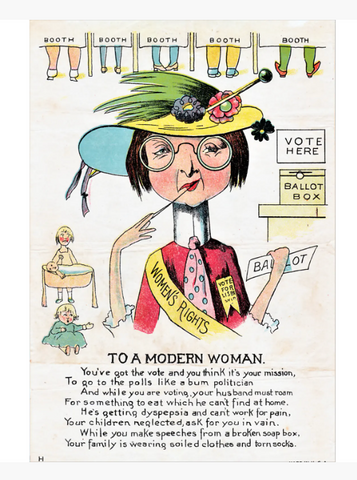
You've got the vote and think it's your mission,
To go to the polls like a bum politician.
And while you are voting, your husband must roam,
For something to eat which he can't find at home.
He's getting dyspepsia and can't work for pain,
Your children neglected, you for you in vain.
While you make speeches from a broken soapbox,
Your family is wearing soiled clothes and torn socks.
A recent NPR story quoted food and candy historian Susan Benjamin, “According to the Boston Globe — and this is in 1886 — one factory alone pumped out 15 million comic [vinegar] valentines and a measly 5 million sentimental ones,”
These Vinegar Valentines peaked In popularity the Victorian era in the US and England. In England, postmasters sometimes refused to deliver the vinegar Valentine's Day cards because they were considered inappropriate and too vulgar. Although some continued until the 1950s.
Does the following card sort of straddle the definition between vinegar and romantic? The design initially strikes us as fairly typical with a beautiful young woman protecting behind her skirts, cupid with his bow and arrow. Yet, the headline, "On the Warpath, Prang's Valentines" adds an eyebrow-raising tone to the message. Is it referring to Cupid being on the warpath to pierce your heart with an arrow? If so, doesn't that add an air of brutality to the whole cupid message?
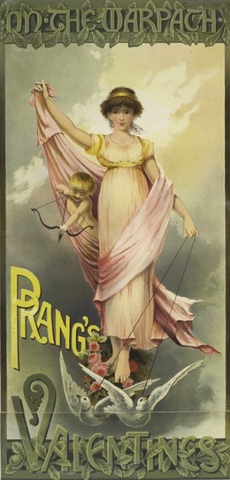
Issued approximately 1899. In the Miriam and Ira D. Wallach Division of Art, Prints, and Photographs: Print Collection,The New York Public Library, digital collection. "Prang's Valentine's: On the Warpath."
More Traditional Themes of Cupid, Hearts, Flowers, and Love
Speaking of hearts, this one seems to be understating the benefits of the romantic pursuer by referring to himself as "a pretty good heart."

In the Miriam and Ira D. Wallach Division of Art, Prints, and Photographs: Print Collection, The New York Public Library, digital collection, a postcard with a St. Valentine's Greeting.
I like the idea of cupids as artists painting a plump cherry red Valentine. I don't know why it seems to be on fire.

By Chordboard - Self, from material in my possession., Public Domain, https://commons.wikimedia.org/w/index.php?curid=4310843.
Here is the front of a sweet, loving Valentine's Day Card:
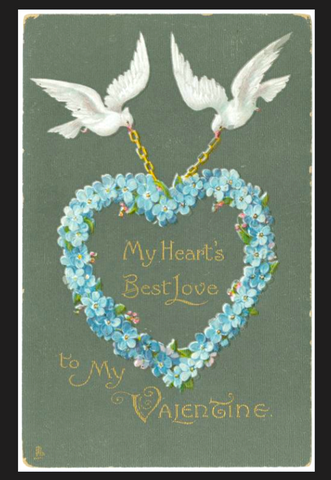
Here is the back of the card. It was posted over a hundred years ago to a granddaughter in Brooklyn, NY. The grandmother has signed it: "Grandmama [with a second name, that I can't decipher.]"
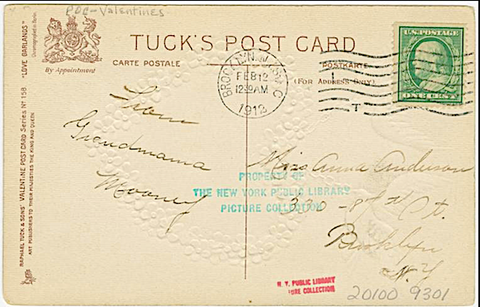
In the Miriam and Ira D. Wallach Division of Art, Prints, and Photographs: Print Collection, The New York Public Library, digital collection.
Many fancy cards of the early late 19th Century and early 20th Century often had glued on ribbons, hearts, bows, and other little bits of ephemera. They may be die-cut or hand-cut and have ornate decorations with almost a rococo-flair of bountiful twisting flower elements, and scrolls.

An English Victorian era Valentine from the Museum of London. Unknown artist.
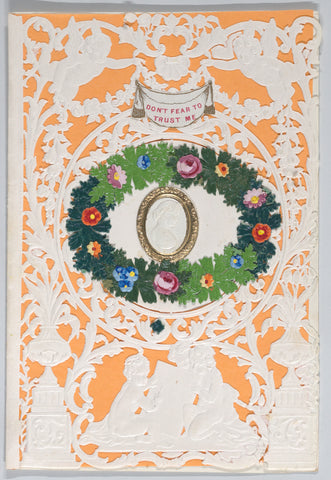
I get a kick out of the understated, modest message on this intricately die-cut Valentine, "Don't Fear to Trust Me." From the collection of the Met, NYC. The green-colored elements are pasted in the center oval. There is a pressed paper cameo of a woman in the center of the card.

Close-up of the center of the card from The Met. It is entitled "Valentine" and described as "Cameo embossed paper, die cut with hand-painted scraps." Created by unknown artist, 1850.
What a lovely gift to a beloved.
Another cut-paper card is shown below. Not exclusively a Valentine's Card but a magnum opus of the paper-cutting technique. (See my two blog posts on the art of paper cutting.)
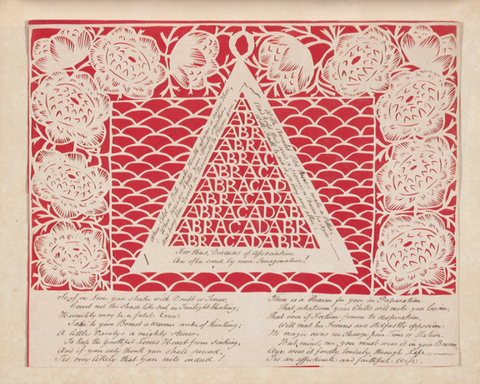
Carl H. Pforzheimer Collection of Shelley and Hiw Circle, The New York Public Library, digital collection "Abacadabra Pyramid," 1823.
I love this card below. There are a number of ways that this card is unusual. First it is not the traditional colors of the holiday. It features warm, golden colors. And a common dandelion is a far cry from red roses.
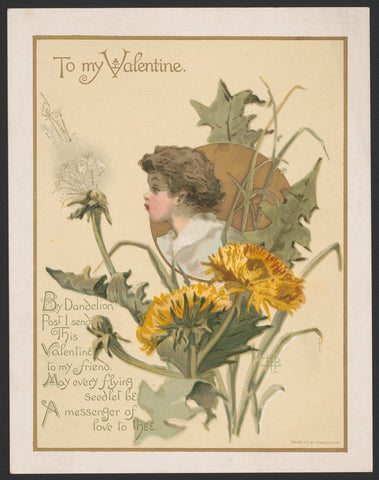
From the collection of the Library of Congress, Photo, Print, Drawing: To My Valentine. L. Prang and Company, Boston, 1992.
The card includes the sentiment:
To My Valentine,
By Dandelion Post I send this Valentine to my friend,
May every flying seedlet be a message of love to Thee.
Another favorite of mine is this charming illustration of a girl painting her bulldog with Valentine hearts while a second and third dog look on.

From the digital collection of the NYPL, NYC. The Miriam and Ira D. Wallach Division of Art, Prints and Photographs: Picture Collection. "To my Valentine." The New York Public Library Digital Collections.
Magazines often featured Valentine's Day covers.
This is Saturday Evening Post cover from February 11, 1956, by Richard Sargent. It depicts a possibly teenage or pre-teen boy trying to be inconspicuous as he selects a Valentine.
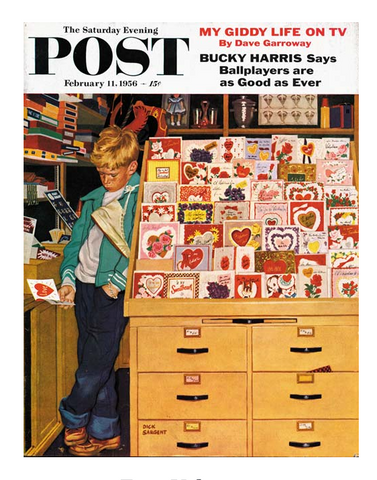
From the collection of covers from The Saturday Evening Post.
So many ways to express your feelings on Valentine's Day! Hope yours is full of love, smiles, hugs, and maybe some chocolate!
Did you like this information? All of my blog posts start as an e-letter and my next e-letter is due out soon. Don't miss out!








Send a message or leave a comment